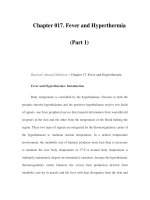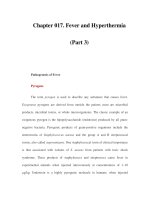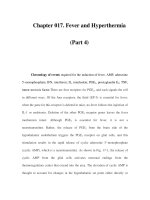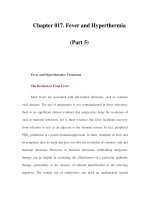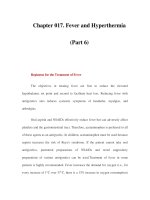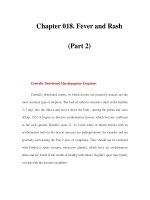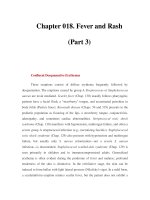Chapter 018. Fever and Rash (Part 3) potx
Bạn đang xem bản rút gọn của tài liệu. Xem và tải ngay bản đầy đủ của tài liệu tại đây (20.12 KB, 6 trang )
Chapter 018. Fever and Rash
(Part 3)
Confluent Desquamative Erythemas
These eruptions consist of diffuse erythema frequently followed by
desquamation. The eruptions caused by group A Streptococcus or Staphylococcus
aureus are toxin mediated. Scarlet fever (Chap. 130) usually follows pharyngitis;
patients have a facial flush, a "strawberry" tongue, and accentuated petechiae in
body folds (Pastia's lines). Kawasaki disease (Chaps. 54 and 319) presents in the
pediatric population as fissuring of the lips, a strawberry tongue, conjunctivitis,
adenopathy, and sometimes cardiac abnormalities. Streptococcal toxic shock
syndrome (Chap. 130) manifests with hypotension, multiorgan failure, and often a
severe group A streptococcal infection (e.g., necrotizing fasciitis). Staphylococcal
toxic shock syndrome (Chap. 129) also presents with hypotension and multiorgan
failure, but usually only S. aureus colonization—not a severe S. aureus
infection—is documented. Staphylococcal scalded-skin syndrome (Chap. 129) is
seen primarily in children and in immunocompromised adults. Generalized
erythema is often evident during the prodrome of fever and malaise; profound
tenderness of the skin is distinctive. In the exfoliative stage, the skin can be
induced to form bullae with light lateral pressure (Nikolsky's sign). In a mild form,
a scarlatiniform eruption mimics scarlet fever, but the patient does not exhibit a
strawberry tongue or circumoral pallor. In contrast to the staphylococcal scalded-
skin syndrome, in which the cleavage plane is superficial in the epidermis, toxic
epidermal necrolysis (Chap. 56), a maximal variant of Stevens-Johnson syndrome,
involves sloughing of the entire epidermis, resulting in severe disease. Exfoliative
erythroderma syndrome (Chaps. 53 and 56) is a serious reaction associated with
systemic toxicity that is often due to eczema, psoriasis, mycosis fungoides, or a
severe drug reaction.
Vesiculobullous Eruptions
Varicella (Chap. 173) is highly contagious, often occurring in winter or
spring. At any point in time, within a given region of the body, varicella lesions
are in different stages of development. In immunocompromised hosts, varicella
vesicles may lack the characteristic erythematous base or may appear
hemorrhagic. Lesions of Pseudomonas "hot-tub" folliculitis (Chap. 145) are also
pruritic and may appear similar to those of varicella. However, hot-tub folliculitis
generally occurs in outbreaks after bathing in hot tubs or swimming pools, and
lesions occur in regions occluded by bathing suits. Lesions of variola (smallpox;
Chap. 214) also appear similar to those of varicella but are all at the same stage of
development in a given region of the body. Variola lesions are most prominent on
the face and extremities, while varicella lesions are most prominent on the trunk.
Herpes simplex virus infection (Chap. 172) is characterized by hallmark grouped
vesicles on an erythematous base. Primary herpes infection is accompanied by
fever and toxicity, while recurrent disease is milder. Rickettsialpox (Chap. 167) is
often documented in urban settings and is characterized by vesicles. It can be
distinguished from varicella by an eschar at the site of the mouse-mite bite and the
papule/plaque base of each vesicle. Disseminated Vibrio vulnificus infection
(Chap. 149) or ecthyma gangrenosum due to Pseudomonas aeruginosa (Chap.
145) should be considered in immunosuppressed individuals with sepsis and
hemorrhagic bullae.
Urticarial Eruptions
Individuals with classic urticaria ("hives") usually have a hypersensitivity
reaction without associated fever. In the presence of fever, urticarial eruptions are
usually due to urticarial vasculitis (Chap. 319). Unlike individual lesions of
classic urticaria, which last up to 48 h, these lesions may last up to 5 days.
Etiologies include serum sickness (often induced by drugs such as penicillins,
sulfas, salicylates, or barbiturates), connective-tissue disease (e.g., systemic lupus
erythematosus or Sjögren's syndrome), and infection (e.g., with hepatitis B virus,
enteroviruses, or parasites). Malignancy may be associated with fever and chronic
urticaria (Chap. 54).
Nodular Eruptions
In immunocompromised hosts, nodular lesions often represent disseminated
infection. Patients with disseminated candidiasis (often due to Candida tropicalis)
may have a triad of fever, myalgias, and eruptive nodules (Chap. 196).
Disseminated cryptococcosis lesions (Chap. 195) may resemble molluscum
contagiosum (Chap. 176). Necrosis of nodules should raise the suspicion of
aspergillosis (Chap. 197) or mucormycosis (Chap. 198). Erythema nodosum
presents with exquisitely tender nodules on the lower extremities. Sweet's
syndrome (Chap. 54) should be considered in individuals with multiple nodules
and plaques, often so edematous that they give the appearance of vesicles or
bullae. Sweet's syndrome may affect either healthy individuals or persons with
lymphoproliferative disease.
Purpuric Eruptions
Acute meningococcemia (Chap. 136) classically presents in children as a
petechial eruption, but initial lesions may appear as blanchable macules or
urticaria. RMSF should be considered in the differential diagnosis of acute
meningococcemia. Echovirus 9 infection (Chap. 184) may mimic acute
meningococcemia; patients should be treated as if they have bacterial sepsis since
prompt differentiation of these conditions may be impossible. Large ecchymotic
areas of purpura fulminans (Chaps. 136 and 265) reflect severe underlying
disseminated intravascular coagulation, which may be due to infectious or
noninfectious causes. The lesions of chronic meningococcemia (Chap. 136) may
have a variety of morphologies, including petechial. Purpuric nodules may
develop on the legs and resemble erythema nodosum but lack its exquisite
tenderness. Lesions of disseminated gonococcemia (Chap. 137) are distinctive,
sparse, countable hemorrhagic pustules, usually located near joints. The lesions of
chronic meningococcemia and those of gonococcemia may be indistinguishable in
terms of appearance and distribution. Viral hemorrhagic fever (Chaps. 189 and
190) should be considered in patients with an appropriate travel history and a
petechial rash. Thrombotic thrombocytopenic purpura (Chaps. 54, 101, and 109)
and hemolytic-uremic syndrome (Chaps. 109, 143, and 147) are closely related and
are noninfectious causes of fever and petechiae. Cutaneous small-vessel vasculitis
(leukocytoclastic vasculitis) typically manifests as palpable purpura and has a wide
variety of causes (Chap. 54).
Eruptions with Ulcers or Eschars
The presence of an ulcer or eschar in the setting of a more widespread
eruption can provide an important diagnostic clue. For example, the presence of an
eschar may suggest the diagnosis of scrub typhus or rickettsialpox (Chap. 167) in
the appropriate setting. In other illnesses (e.g., anthrax; Chap. 214), an ulcer or
eschar may be the only skin manifestation.
FURTHER READINGS
Cherry JD: Contemporary infectious exanthems. Clin Infect Dis 16:199,
1993 [PMID: 8443297]
———: Cutaneous manifestations of systemic infections, in Textbook of
Pediatric Infectious Diseases, vol. 1, 4th ed, RD Feigin, JD Cherry (eds).
Philadelphia, Saunders, 1998, pp 713–737
Eichenfield LF et al (eds): Textbook of Neonatal Dermatology.
Philadelphia, Saunders, 2001
Freedberg IM et al (eds): Fitzpatrick's Dermatology in General Medicine,
6th ed. New York, McGraw-Hill, 2003
Levin S, Goodman LJ: An approach to acute fever and rash (AFR) in the
adult. Curr Clin Top Infect Dis 15:19, 1995 [PMID: 7546368]
Paller AS, Mancini AJ (eds): Hurwitz Clinical Pediatric Dermatology, 3d
ed. Philadelphia, Elsevier Saunders, 2006
Schlossberg D: Fever and rash. Infect Dis Clin North Am 10:101, 1996
[PMID: 8698985]
Weber DJ et al: The acutely ill patient with fever and rash, in Principles
and Practice of Infectious Diseases, vol 1, 6th ed, GL Mandell et al (eds).
Philadelphia, Elsevier Churchill Livingstone, 2005, pp 729–746
Wenner HA: Virus diseases associated with cutaneous eruptions. Prog Med
Virol 16:269, 1973 [PMID: 4356897]
Wolff K, Johnson RAJ: Fitzpatrick's Color Atlas and Synopsis of Clinical
Dermatology, 5th ed. New York, McGraw-Hill, 2005


